Related Research Articles

JATO is a type of assisted take-off for helping overloaded aircraft into the air by providing additional thrust in the form of small rockets. The term JATO is used interchangeably with the term RATO, for rocket-assisted take-off.

Junkers Flugzeug- und Motorenwerke AG more commonly Junkers, was a major German aircraft and aircraft engine manufacturer. It was founded in Dessau, Germany, in 1895 by Hugo Junkers, initially manufacturing boilers and radiators. During World War I and following the war, the company became famous for its pioneering all-metal aircraft. During World War II the company produced the German air force's planes, as well as piston and jet aircraft engines, albeit in the absence of its founder who had been removed by the Nazis in 1934.

The Messerschmitt Me 263 Scholle (plaice) was a rocket-powered fighter aircraft developed from the Me 163 Komet towards the end of World War II. Three prototypes were built but never flown under their own power as the rapidly deteriorating military situation in Germany prevented the completion of the test program.

The Junkers Ju 287 was a multi-engine tactical jet bomber built in Nazi Germany in 1944. It featured a novel forward-swept wing, and the first two prototypes were among the very few jet propelled aircraft ever built with fixed landing gear.
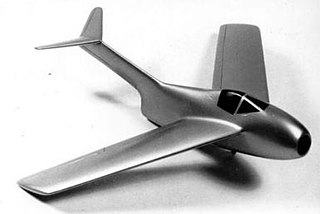
The Focke-Wulf Ta 183 Huckebein was a design for a jet-powered fighter aircraft intended as the successor to the Messerschmitt Me 262 and other day fighters in Luftwaffe service during World War II. It had been developed only to the extent of wind tunnel models when the war ended, but the basic design was further developed postwar in Argentina as the FMA IAe 33 Pulqui II. The name Huckebein is a reference to a trouble-making raven from an illustrated story in 1867 by Wilhelm Busch.

The Emergency Fighter Program was the program that resulted from a decision taken on July 3, 1944 by the Luftwaffe regarding the German aircraft manufacturing companies during the last year of the Third Reich.

Wunderwaffe is a German word meaning "wonder-weapon" and was a term assigned during World War II by Nazi Germany's propaganda ministry to some revolutionary "superweapons". Most of these weapons however remained prototypes, which either never reached the combat theater, or if they did, were too late or in too insignificant numbers to have a military effect. The V-weapons, which were developed earlier and saw considerable deployment, especially against London and Antwerp, trace back to the same pool of highly inventive armament concepts. In the German language, the term Wunderwaffe generally refers to a universal solution which solves all problems related to a particular issue, mostly used ironically for its illusionary nature.
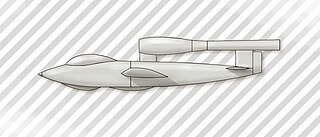
The Junkers EF 126 was an experimental fighter proposed by the German Miniaturjägerprogramm of 1944–1945, for a cheap and simple fighter powered by a pulsejet engine. No examples were built during the war, but the Soviet Union completed both unpowered and powered prototypes.
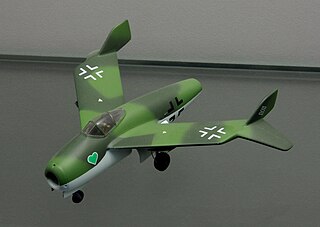
The Blohm & Voss P 212 was a proposed jet fighter designed by Blohm & Voss for the Emergency Fighter Program Luftwaffe design competition during the Second World War.
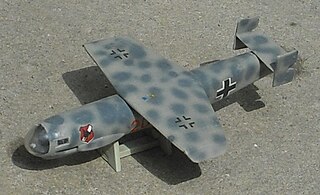
The Heinkel P.1077 was a single seat interceptor design developed for the Luftwaffe by Heinkel under the Emergency Fighter Program during the last year of the Third Reich. This rocket-powered project was originally known as He P.1068, but that name was later used for a Heinkel design project for a turbojet-powered medium bomber.
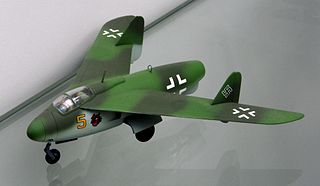
The Junkers EF 128 was a project for a single-engine jet fighter, developed for the Emergency Fighter Program Luftwaffe design competition during the Second World War.

The Messerschmitt P.1079 was a series of different experimental Messerschmitt fighters projected during the Second World War. The last designs were proposed in 1944 towards the end of the Third Reich. Except for the last one, all the aircraft designs were to be powered by pulse jets, the same engines used in the V-1 flying bomb.
The Messerschmitt P.1103 Panzerjäger and P.1104 were a series of rocket-powered interceptors proposed by Messerschmitt.
The von Braun Interceptor was a VTOL rocket-powered interceptor designed by Wernher von Braun. This aircraft would have used the technology Von Braun had developed for the V-2 rocket during World War II. Von Braun put forward the proposal to Reichsluftfahrtministerium, on July 6, 1939, but project was ultimately not built.
References
- ↑ Albrect, Ulrich (2003). Monika Renneberg, Mark Walker (ed.). Science, Technology, and National Socialism. Cambridge University Press. pp. 116–117. ISBN 978-0521528603.